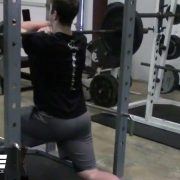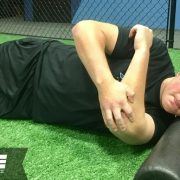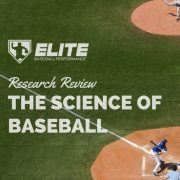How to Throw to Prepare the Arm for the Season
One of the most important concepts when trying to prepare the arm for the baseball season is developing an appropriate offseason throwing program. It is important that any throwing program consists of a rest period after a long summer, followed by a rebuilding period to prepare the arm for the upcoming season.
During the rebuilding period, it is important to stay off of the mound for an initial four week, base building period. The idea is that the better you build your base in the fall and winter months, the better you can maximize your health, strength, and endurance during the season.
The key to optimizing the health, strength, and endurance of your arm inseason is significantly reflected by how well you can maintain this base throughout the offseason months, and then how well it carries over into the season.
The following article will discuss how to transition your offseason throwing program into mound work to prepare the arm for the season. If you are interested in learning more, we have our brand new online version of our Thrive on Throwing 2 video where we show you exactly how to perform the Jaeger Throwing Programs, as well as a downloadable Year Round Throwing Manual that builds off this information and discusses how to best prepare your throwing programs throughout the year for optimal success. More information on these can be found below.
This article is part of a 3 part series on year round throwing:
- Part 1 – Building Your Offseason Baseball Throwing Program
- Part 2 – Preparing Your Arm for the Baseball Season
- Part 3 – Keys to a Baseball Inseason Throwing Program
How to Throw to Prepare the Arm for the Season
After a pitcher has gone through the initial offseason phase of resting his arm and rebuilding his base correctly through among other things, arm care exercises and long toss, there are two more stages to go through before pitchers transition into the inseason training or maintenance phase.
- Stage 1 involves the integration of mound work, bullpens, and live batting practice
- Stage 2 addresses the transition into the spring inseason maintenance period
The goal of this article is to understand the importance of maintaining your base and optimizing your recovery time once throwing off a mound is introduced in the offseason. This is best accomplished by understanding that throwing off a mound is an extension of your Long Toss throwing program, rather than the primary focus. In other words, Long Toss is the key to your workload each day, and if you get on a mound, it is simply the culmination of your throwing program.
As you will see throughout this article Long Toss is what most effectively replenishes the base and significantly improves recovery period after any form of “mound work.” Maintaining a strong base and optimizing recovery time are the key factors in optimizing health, strength, and endurance throughout the year. This article is written with this in mind.
Stage 1 – Integrating Bullpens into Your Offseason Throwing
After the arm has had a minimum of 4-6 week offseason period to rest and rebuild without throwing off the mound, the pitcher is ready to begin to integrate bullpens into his throwing program.
Because such a strong base was built from the previous phase, bullpens should have a dramatically less effect on producing arm soreness. The arm will recover faster, which in turn will allow the base to be minimally affected or “depleted.” This is a critical principle to understand because having great recovery is the essential ingredient to maintaining arm health, strength and endurance throughout the year.
In the case of a pitcher who has extended his Long Toss to 5 days a week leading into his first week of bullpens, the main priority on bullpen days is for the pitcher to think conditioning and long toss first, and mound work second.
Essentially, the bullpen is used to “culminate” the workout, rather than be the focus of the throwing that day.
The idea is that when the arm can “stretch out” through Long Toss, it is most effectively prepared to throw off the mound. To put it another way, the focal point of each day is to condition the arm, and then use the bullpen for pitching specific skills, such as working on mechanics or getting used to throwing with the decline of the mound.
Many coaches make the mistake of “saving the arm” for the bullpen by minimizing the amount of throwing on “bullpen days.” In my experience, this has the opposite effect on the arm — it is telling the arm to throw aggressively before it has been properly stretched out and conditioned. It’s like running only a mile each day to “save your legs” for a marathon at the end of the week. This mentality of “saving the arm for the bullpen” is the primary reason why recovery periods worsen, and the pitcher’s base becomes depleted. The same principle also applies to inseason bullpens and game situations.
How often a pitcher integrates bullpens into the offseason months is a feel thing from player to player. But the bottom line is to integrate workload slowly and progressively into your bullpen sessions just as you worked slowly and incrementally into your Long Toss routine when you built your initial base. I would recommend two bullpens a week through the offseason months, separated by as many recovery period days as possible. For example, a Monday/Friday is an ideal format because you maximize your “off days” from bullpen to bullpen. These off days away from mound work allow the arm optimal time to recover and recondition itself for the next bullpen. The amount of pitches thrown in the bullpen and the intensity behind it again varies from pitcher to pitcher (and the workload that preceded it).
The priority is that the arm is stretched out thoroughly through a Long Toss program before any mound work. Remember, the recovery period between bullpens is crucial because the better your recovery period, the more the arm is going to want to “stretch it out” from day to day.
Stretching the arm out is what replenishes the arm.
Having great recovery periods leads to what I call a “positive cycle” – a positive cycle because the arm wants to throw more rather than less from day-to-day because it feels good. Essentially, the arm can sustain it’s base throughout the offseason and into the season because bullpens and game action have a minimal effect on recovery period. If the recovery period between pens is poor, and the arm is unusually sore, the arm will need to rest more often, which further deprives the base from getting replenished. This is what we call a “negative cycle” which exposes the arm to breaking down.
As you go through the offseason months, the primary goal is to stay in a conditioning mode as you increase the pitch counts in bullpen situations. As bullpens turn into game action, the principle doesn’t change. Bullpens and game situations are interchangeable. So if you throw a bullpen or pitch in a game situation on Monday/Friday, your goal is to continue to Long Toss at least one other day of the week. Remember, your bullpen/game day are also relatively thorough Long Toss days.
The idea with this offseason mentality is to keep the focus on Long Toss as you increase pitch counts for bullpens and game situations. Because a thorough Long Toss session is incorporated at least three days a week, the arm is best positioned to stay in a positive cycle through the end of offseason, despite the reality that pitch counts can elevate up to 45-60 pitches in game situations.
Once a pitcher starts throwing bullpens in the offseason, he will find that the days he is going to throw off a mound are his best Long Toss days because he will have the most amount of recovery period days between mound work. With that said, it should be noted that the day after a pitcher’s mound work, Long Toss will probably consist of only the “stretching out” phase and the distance may only consist of about 50-75% of a pitcher’s normal distance. This is important to understand because Long Toss after mound work should be less aggressive with the focus being on “stretching” the arm out.
If done right, the second day after mound work will lead to a more typical distance of Long Toss, and the “pull-down” or more aggressive phase of Long Toss can be added if it feels right. Remember, it always comes down to “listening to your arm.” Once mound work begins, your focus is on stretching the arm out each day. How far you go out and how aggressive you “pull down” from day-to-day depends simply on how your arm feels, and how good your recovery period is.
Phase 2 – Transition Throwing from the Offseason into the Inseason
Once the Winter Holidays come and go (this is traditionally a 2-3 week window) and players return to school, pitchers need to be able to spend at least two weeks off the mound to recondition their arm. For the same reasons why pitchers use the first 4-6 weeks in the Fall to stay off the mound to condition, players need to “rebuild” the base for the first two weeks without even thinking about mound work. This is essential to understand because these two weeks allows the pitcher to reconnect to the base that was built all offseason. Fortunately, because the arm was so well “built” in the offseason, it only takes a couple of weeks to “re-catch” the wave, especially if the pitcher spent the Winter break doing his arm care program and playing some form of catch.
Once this two week period has been established the pitcher is ready to integrate bullpens and game innings into his throwing routine. This should come quickly. A pitcher should be able to go from throwing a 25 pitch bullpen in week 3 (late January/early February) to throwing 35 pitches in an inter-squad game by week 4.
Naturally, because High School and College seasons begin at different times, how you integrate bullpens and game situations depends on many variables. The priority here is still about learning how to prioritize your conditioning off of the mound for two weeks after the Winter break so the base is reinforced and the recovery period is sufficient once mound work is reintroduced. Remember, once the Spring starts getting close, the tendencies are to ramp up the pitch count and prepare for game situations. This is an even greater reason to use the first two weeks for base building — otherwise, you may be putting the pitcher’s arm in harm’s way.
The Key to Preparing the Arm for the Season
Remember, the ideal way to maintain an arm inseason is to have a great base in place from the offseason.
This offseason base is the key to having a great recovery period, which in turn allows the arm to recondition itself most effectively as mound work is integrated into the offseason months, and eventually into the Spring season. This ability to maintain good recovery periods and a Long Toss program as bullpens and game situations are integrated is the key to not only maintaining a healthy arm throughout the offseason but also to positioning your arm to get more durable and possibly even stronger throughout the season.
Finally, always “listen to your arm.”
Only it knows from day to day what it needs and what it wants. Because you have learned to condition and maintenance it so well the reality is you will probably find yourself wanting to stretch your arm out with Long Toss more often than you have in the past. But this is a great sign. It’s a reminder that the body responds best to activity rather than inactivity. The arm wants to regenerate, not degenerate. And when the arm gets into this “positive cycle,” the arm is in the best position possible throughout the year to stay healthy, strong and durable.
Learn the Jaeger Long Toss Program

We also have a more detailed Year Round Throwing Manual that builds off this article in much more detail and shows you exactly what to do for a throwing program throughout the entire year.
If you don’t have a structured throwing program that you follow, this is an essential place to start:
- Click here for more information on the online version of the Jaeger Thrive on Throwing 2 program
- Click here for more information on the downloadable Jaeger Year Round Throwing Manual
Alan Jaeger
Latest posts by Alan Jaeger (see all)
- Building Your Offseason Baseball Throwing Program - October 24, 2017
- A Daily Mental Practice for Baseball Players - September 12, 2017
- Keys to an Inseason Throwing Program - March 1, 2017










Hey I am a catcher and I am having anterior shoulder pain I was wondering if I am putting to much stress in the wrong places. Could that be why I had tendentious.
Hey Jackson…can be many possibilities — lack of conditioning, not enough arm care, not enough off season build up — could also be as simple as mechanics, overuse, etc. Wish I had more for you. But “pain” usually means back off…rest/active rest….and then rebuild slowly and surely. Hope that helps buddy!! Alan
Hey Jackson…can be many possibilities — lack of conditioning, not enough arm care, not enough off season build up — could also be as simple as mechanics, overuse, etc. Wish I had more for you. But “pain” usually means back off…rest/active rest….and then rebuild slowly and surely. Hope that helps buddy!! Alan